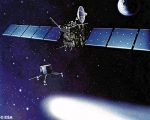Displaying items by tag: robotics
Honeybee Robotics Spacecraft Mechanisms Corporation
Honeybee Robotics Spacecraft Mechanisms Corporation is a spacecraft technology and robotics company located in New York, USA.
Honeybee Robotics has particular expertise in developing and operating small mechanical tools used on Mars missions. Some of the robotic devices it has developed and successfully demonstrated on Mars include:
- The Rock Abrasion Tool (RAT) instruments used on both Mars Exploration Rovers.
- The Icy Soil Acquisition Device (ISAD), sometimes called the "Phoenix Scoop", a soil scoop and a precision ice-sampling tool successfully demonstrated on the 2008 Mars Phoenix Lander mission,
- The Sample Manipulation System and Dust Removal Tool used on the Mars Science Laboratory mission, which landed in August 2012.
- In addition, they are developing tools to be used to live and work on the moon as part of NASA's Constellation program.
Honeybee Robotics delivers flight-qualified products, from specialized mechanical components to precision positioning and deployment systems. It also offesr a range of engineering services, from specification development to design, build, test, and integration of a final product.
Honeybee Robotics was established in 1983.
Magellium
Magellium is a company of specialists on the leading edge of technology who leverage their expert knowledge in signal and image processing, geomatics, innovative learning technologies, robotics and intelligent systems to offer high value-added engineering, systems design, solutions and services.
Its activities cover Space, Defense & Security, Health, Industry.
Lunabotics Mining Competition
NASA's Annual Lunabotics Mining Competition is a university-level competition designed to engage and retain students in science, technology, engineering and mathematics (STEM).
NASA will directly benefit from the competition by encouraging the development of innovative lunar excavation concepts from universities which may result in clever ideas and solutions which could be applied to an actual lunar excavation device or payload. The challenge is for students to design and build an excavator, called a Lunabot, that can mine and deposit a minimum of 10 kilograms of lunar simulant within 10 minutes. The complexities of the challenge include the abrasive characteristics of the BP-1, the weight and size limitations of the Lunabot, and the ability to telerobotically or autonomously control the Lunabot from a remote mission control center. This year the scoring for the mining category will not be based primarily on the amount of material excavated in the allowed time but instead will require teams to consider a number of design and operation factors such as dust tolerance and projection, communications, vehicle mass, energy/power required, and full autonomy.
Robonaut
A Robonaut is a dexterous humanoid robot built and designed at NASA Johnson Space Center in Houston, USA.
Robonaut differs from other current space-faring robots in that, while most current space robotic systems (such as robotic arms, cranes and exploration rovers) are designed to move large objects, Robonaut's tasks require more dexterity.
The core idea behind the Robonaut series is to have a humanoid machine work alongside astronauts.
The challenge is to build machines that can help humans work and explore in space. Working side by side with humans, or going where the risks are too great for people, Robonauts will expand our ability for construction and discovery. Central to that effort is a capability called dexterous manipulation, embodied by an ability to use one's hand to do work. The challenge is to build machines with dexterity that exceeds that of a suited astronaut.
Robonaut version R2 flew on the ISS, delivered by STS-133, in Feb 2011.
Jet Propulsion Laboratory (JPL)
The Jet Propulsion Laboratory (JPL) is a federally funded research and development center and NASA field center located in California, USA. JPL is managed by the nearby California Institute of Technology (Caltech) for the National Aeronautics and Space Administration (NASA).
The Laboratory's primary function is the construction and operation of robotic planetary spacecraft, though it also conducts Earth-orbit and astronomy missions. It is also responsible for operating NASA's Deep Space Network.
Among the Laboratory's major projects are the Mars Science Laboratory mission (which includes the Curiosity rover), the Cassini–Huygens mission orbiting Saturn, the Mars Exploration Rovers (Spirit and Opportunity), the Mars Reconnaissance Orbiter, the Dawn mission to the dwarf planet Ceres and asteroid Vesta, the Juno spacecraft en route to Jupiter, the Gravity Recovery and Interior Laboratory (GRAIL) mission to the Moon, the Nuclear Spectroscopic Telescope Array (NuSTAR) X-ray telescope, and the Spitzer Space Telescope.
Rosetta spacecraft
Rosetta is a robotic spacecraft of the European Space Agency on a mission to study the comet 67P/Churyumov–Gerasimenko. Rosetta consists of two main elements:
- the Rosetta space probe;
- the Philae lander.
The spacecraft was launched on 2 March 2004 on an Ariane 5 rocket and will reach the comet by mid 2014. The space probe is intended to orbit and perform long-term exploration of the comet at close quarters. On 10 November 2014 the Philae lander will attempt to land and perform detailed investigations on the comet's surface. Both the probe and the lander carry a large complement of scientific experiments designed to complete the most detailed study of a comet ever attempted.
The probe is named after the Rosetta Stone, as it is hoped the mission will help form an idea of how the solar system looked before planets formed. The lander is named after the Nile island Philae where an obelisk was found that helped decipher the Rosetta Stone. The spacecraft has already performed two successful asteroid flyby missions on its way to the comet. In 2007 performed a Mars swingby (flyby), and returned images. The craft completed its fly-by of asteroid 2867 Šteins in September 2008 and of 21 Lutetia in July 2010, and is presently (2013) in hibernation and on-target for its final destination as of June 2013.
Phoenix (spacecraft)
Phoenix was a robotic spacecraft on a space exploration mission on Mars under the Mars Scout Program.
The Phoenix lander descended on Mars on May 25, 2008. Mission scientists used instruments aboard the lander to search for environments suitable for microbial life on Mars, and to research the history of water there.
The multi-agency program was headed by the Lunar and Planetary Laboratory at the University of Arizona, under the direction of NASA's Jet Propulsion Laboratory. The program was a partnership of universities in the United States, Canada, Switzerland, Denmark, Germany, the United Kingdom, NASA, the Canadian Space Agency, the Finnish Meteorological Institute, Lockheed Martin Space Systems, MacDonald Dettwiler & Associates (MDA) and other aerospace companies. It was the first mission to Mars led by a public university in NASA history. The mission underscored the value of university-led management. It was led directly from the University of Arizona's campus in Tucson, with project management at the Jet Propulsion Laboratory in Pasadena, Calif., and project development at Lockheed Martin in Denver, Colorado. The operational funding for the mission extended through November 10, 2008.
Phoenix is NASA's sixth successful landing out of seven attempts and is the most recent spacecraft to land successfully on Mars as well as the first successful landing in a Martian polar region. The lander completed its mission in August 2008, and made a last brief communication with Earth on November 2 as available solar power dropped with the Martian winter. The mission was declared concluded on November 10, 2008, after engineers were unable to re-contact the craft. After unsuccessful attempts to contact the lander by the Mars Odyssey orbiter up to and past the Martian summer solstice on May 12, 2010, JPL declared the lander to be dead. Like the two Mars Exploration Rovers, the program was considered a success because it completed all planned science experiments and observations.







